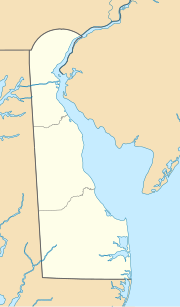Murderkill River
| Murderkill River | |
| River | |
|
The Murderkill River downstream of Killens Pond in 2006
|
|
| Country | United States |
|---|---|
| State | Delaware |
| Source | |
| - location | near Felton |
| - coordinates | 39°01′03″N 75°35′31″W / 39.01750°N 75.59194°W |
| Mouth | Delaware Bay |
| - location | Bowers |
| - elevation | 3 ft (1 m) |
| - coordinates | 39°03′30″N 75°23′48″W / 39.05833°N 75.39667°WCoordinates: 39°03′30″N 75°23′48″W / 39.05833°N 75.39667°W |
| Length | 22 mi (35 km) |
| Basin | 106 sq mi (275 km2) |
The Murderkill River is a river flowing to Delaware Bay in central Delaware in the United States. It is approximately 21.7 miles (34.9 km) long and drains an area of 106 square miles (270 km2) on the Atlantic Coastal Plain.
The Murderkill flows for its entire length in southern Kent County. It rises just west of Felton and flows generally east-northeastwardly, through Killen Pond (site of Killens Pond State Park) and Coursey Pond, under Carpenters Bridge, and past Frederica to Bowers, where it enters Delaware Bay about 0.5 miles (1 km) south of the mouth of the St. Jones River. The Murderkill River is tidally influenced from its mouth upstream to just past Frederica, and is considered by the U.S. Army Corps of Engineers to be navigable for the lower 10 miles (16 km) of its course.
According to 2002 data from the United States Environmental Protection Agency, 55% of the area of the Murderkill River's watershed is occupied by agricultural uses; 17% is forested; 14% is urban; 9% is wetland; and 2% is water.
The river has suffered a persistent pollution from eutrophication and organic waste in agricultural runoff. Its estuary is considered to have abnormally low rates of dissolved oxygen.
...
Wikipedia


